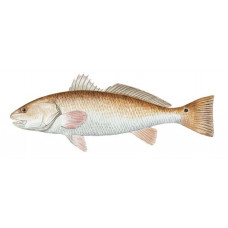Latin name
Sciaenops ocellatus
Other names
Channel bass, redfish, rat red (schooling juveniles less than 2 pounds), bull red (more than 10 pounds), puppy drum (under 18 inches), drum, spottail bass, red bass, red horse, school drum; French: tambour rouge; Spanish: corvinón ocelado, pez rojo, corvina roja, pescado colorado.
Identification
The red drum is similar in appearance to the black drum, although its maximum size is smaller and it is more streamlined. The body is elongate, with a subterminal mouth and a blunt nose. On adults the tail is squared, and on juveniles it is rounded. There are no chin barbels, which also distinguishes it from the black drum. Its coloring is coppery red to bronze on the back, and silver and white on the sides and the belly. One black dot (also called an eyespot) or many are found at the base of the tail.
Distribution
Red drum are found in the western Atlantic Ocean from the Gulf of Maine to the Florida Keys, although they are rare north of Maryland, and all along the Gulf Coast to northern Mexico.
Habitat
Sea-bottom shelf fish, enters brackish and fresh waters. Fry inhabit coastal bays, estuaries, and marshes (marshes) affected by tides. At sea, it occurs on muddy and sandy substrates at depths of less than 50 m. Red drum at the end of life becomes oceanic. It is found in brackish and salty waters on the sandy, muddy and grassy bottoms of bays, shallow bays, tidal passes, bays, and estuaries. Red drum also tolerate fresh water well, in which some of them live permanently. Large red drum favor the deeper waters of lower estuaries and tidal passages, while small red drum remain in shallow waters. Red drum can survive wide ranges of salinity and temperature. Smaller drum prefer lower salinity levels than do larger ones. Optimum salinity levels range from 5 to 30 parts per thousand, optimum temperatures from 40° to 90°F. More big reds and fewer small ones exist in a fairly short stretch of the mid-Atlantic because of the rich feeding opportunities. This is said to keep the fish from migrating southward each fall, as they prefer to move offshore to warmer continental shelf waters until spring.
Size
The average adult red drum is 28 inches long and weighs about 15 pounds. Although red drum can reach enormous sizes, they rarely do. South of the Caroline Islands or in the Gulf of Mexico, 30-pound specimens are rare, although fish up to 60 pounds have been caught in coastal areas. Fish weighing 30 to 50 pounds are most prominent in the mid-Atlantic, mostly in North Carolina and Virginia; these sizes are considered trophies. Red mullet can live for 50 years or more. They are reported to live at least 40 years in the Gulf of Mexico, and the record holder, caught on all tackle in North Carolina, weighing 94 pounds 2 ounces, is said to have lived 53 years.
Life history and Behavior
Males reach maturity by age 4 at 30 inches long and 15 pounds, females by age 5 at 35 inches long and 18 pounds. The spawning period is in the fall, although it may begin as early as August and end in November. Spawning occurs at dusk in the coastal waters of the northern Gulf of Mexico, near passages, bays and inlets, and is often associated with phases of a new or full moon. Just before spawning, males change coloration and become dark red or bright bluish gray over the sideline. Males and females both chase and beat each other with loud drumming hours before mating. A female can release up to 4.5 million eggs, but few survive to adulthood. Currents and winds carry the larvae to feeding areas. Adult red mullet form large flocks in coastal waters. Anglers often see them near the surface, moving under schools of blue char and minnow tuna.
Food and feeding habits
Young red snapper with length less than 15 mm feed on zooplankton, 15-75 mm - mainly on small bottom invertebrates, over 75 mm - on decapods and fish. Adult fish eat predominantly shrimp and crabs, in significant quantities eat other fish and in small - isopods, mollusks, worms. As a bottom fish, this species uses its sensory and tactile organs, as well as a downward-facing mouth, to search for food on the bottom. In shallow water, you can often see them wading head down with their tail slightly out of the water, this behavior is called "tailing."
Reproduction
It spawns off the Atlantic coast of the U.S. from August to November, and off the northern coast of the Gulf of Mexico from September to January. In the Gulf of Mexico, spawning occurs near passages between islands leading to lagoons, bays, and marshes. Fertility is up to 3.5 million eggs.
| Classification | |
| Phylum | Chordata |
| Class | Actinopterygii |
| Squad | Acanthuriformes |
| Family | Sciaenidae |
| Genus | Sciaenops |
| Species | S. ocellatus |
| Features | |
| Conservation status | Least Concern |
| Habitat | Pelagic |
| Life span, years | 60 |
| Maximum body weight, kg | 42.6 |
| Maximum length, cm | 90 |
| Sailing speed, m/s | No information |
| Threat to people | Edible |
| Way of eating | Planktonophage |




